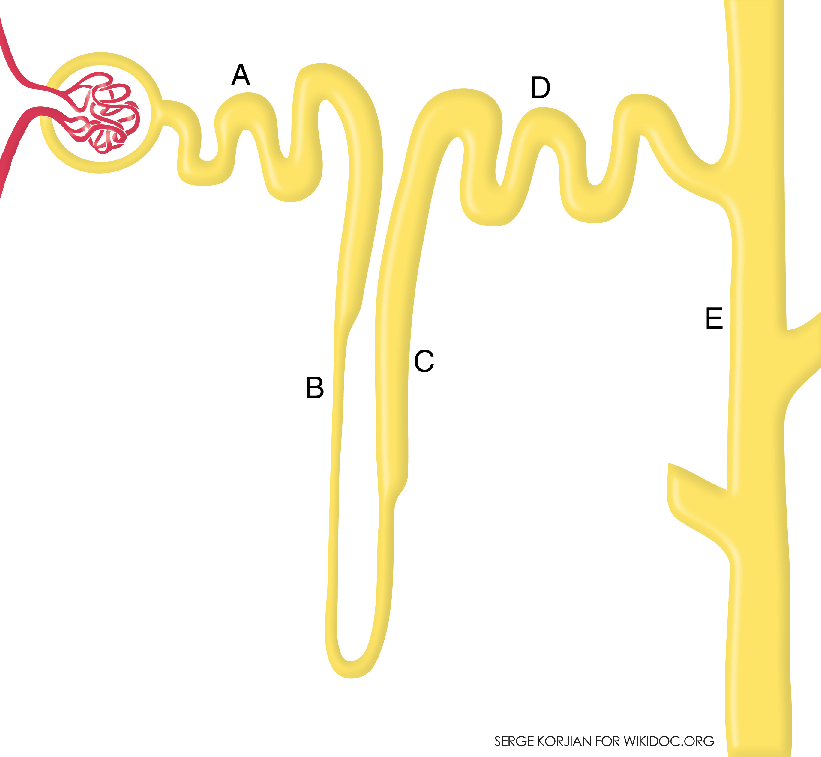WBR0511
| Author | [[PageAuthor::Rim Halaby, M.D. [1]]] |
|---|---|
| Exam Type | ExamType::USMLE Step 1 |
| Main Category | MainCategory::Physiology |
| Sub Category | SubCategory::Renal |
| Prompt | [[Prompt::A researcher is studying the renal handling of calcium along the nephron using rats. In his experiment, he notices that after filtration, more than 90% of calcium is reabsorbed by passive and active mechanisms. Additionally, he notes that calcium reabsorption is dependent on the hormonal effects of parathyroid hormone (PTH). Using the illustration below, which segment of the nephron is responsible for the PTH-mediated reabsorption of calcium? |
| Answer A | AnswerA::A |
| Answer A Explanation | [[AnswerAExp::"A" corresponds to the proximal convoluted tubules. This is not the location where PTH acts to increase the reabsorption of calcium. However, this is the location where the sodium/phosphate co-transporter is inhibited to further excrete phosphate and decrease serum concentrations of phosphate.]] |
| Answer B | AnswerB::B |
| Answer B Explanation | AnswerBExp::"B" corresponds to the descending loop of Henle. This is not the location where PTH acts to increase the reabsorption of calcium. |
| Answer C | AnswerC::C |
| Answer C Explanation | AnswerCExp::"C" corresponds to the ascending loop of Henle. This is not the location where PTH acts to increase the reabsorption of calcium. |
| Answer D | AnswerD::D |
| Answer D Explanation | AnswerDExp::"D" corresponds to the distal convoluted tubule. This is the location where PTH-mediated calcium reabsorption occurs. |
| Answer E | AnswerE::E |
| Answer E Explanation | AnswerEExp::"E" corresponds to the collecting ducts. This is not the location where PTH acts to increase the reabsorption of calcium. |
| Right Answer | RightAnswer::D |
| Explanation | [[Explanation::Calcium homeostasis is important for osteogenesis and resorption of bone. Calcium is maintained in physiological concentrations under the control of parathyroid hormone (PTH). Low serum calcium promote the secretion of PTH into the circulation. PTH allows the resorption of calcium and phosphate in the bones. However, it causes increased GI absorption and renal reabsorption of calcium but decreased phosphate reabsorption in the kidney. As such, PTH generally increases the serum calcium concentrations. Calcium itself acts to inhibit the secretion of PTH in a negative-feedback mechanism. In the kidneys, PTH inhibits the sodium/phosphate co-transporter in the proximal convoluted tubules to promote phosphate excretion. In converse, it increases the calcium/sodium exchanger in the distal convoluted tubule to increase calcium reabsorption and thus increase the serum concentrations of calcium. Educational Objective: PTH increases the calcium/sodium exchanger in the distal convoluted tubules to increase the reabsorption of calcium. |
| Approved | Approved::No |
| Keyword | WBRKeyword::Calcium, WBRKeyword::Serum, WBRKeyword::Concentration, WBRKeyword::renal, WBRKeyword::handling, WBRKeyword::kidney, WBRKeyword::hormone, WBRKeyword::hormonal, WBRKeyword::PTH, WBRKeyword::parathyroid, WBRKeyword::phosphate, WBRKeyword::distal, WBRKeyword::convoluted, WBRKeyword::tubule, WBRKeyword::proximal, WBRKeyword::reabsorption |
| Linked Question | Linked:: |
| Order in Linked Questions | LinkedOrder:: |
